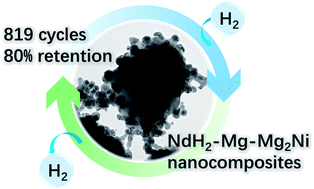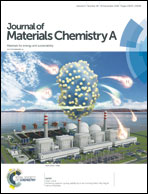Achieving superior cycling stability by in situ forming NdH2–Mg–Mg2Ni nanocomposites†
Abstract
Magnesium hydrides have great potential as hydrogen storage materials for fuel cell technologies, but the poor cycling stability and slow kinetics have severely restrained their commercial applications. In this work, we report the Nd4.3Mg87.0Ni8.7 alloy formed by hydrogen induction with remarkably fast hydrogen storage kinetics and high hydrogen storage capacity (78.6% of the maximum value) even after 819 hydriding/dehydriding (H/D) cycles. In situ synchrotron powder X-ray diffraction and three-dimensional atom probe tomography analysis reveal that the catalytic NdH2 nanocrystallites are in situ formed during the first hydrogenation of Nd4Mg80Ni8 and densely distribute in the matrix of α-Mg and Mg2Ni, which plays the key role in achieving excellent hydrogen storage properties. Analysis using the Johnson–Mehl–Avrami–Kolmogorov (JMAK) model suggests that the diffusion rate of H atoms during hydrogenation is greatly enhanced by the high-density grain boundaries in the NdH2–Mg–Mg2Ni nanocomposites. The pumping effect of NdH3−x, which captures H atoms and transfers them from the 4b sites of NdH3−x to the octahedral interstitial sites of the NdH3−x/α-Mg interface along the [1![[1 with combining macron]](https://www.rsc.org/images/entities/char_0031_0304.gif) 00]Mg direction, is demonstrated via first-principles calculations. The pioneering work presented in this paper with the proposed microstructure evolution mechanism is of great significance to the design and fabrication of new hydrogen storage materials with superior hydrogen storage performances.
00]Mg direction, is demonstrated via first-principles calculations. The pioneering work presented in this paper with the proposed microstructure evolution mechanism is of great significance to the design and fabrication of new hydrogen storage materials with superior hydrogen storage performances.

- This article is part of the themed collection: 2018 Journal of Materials Chemistry A HOT Papers


 Please wait while we load your content...
Please wait while we load your content...